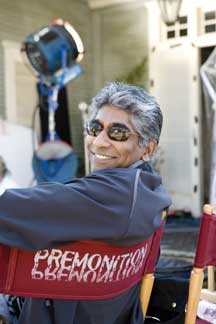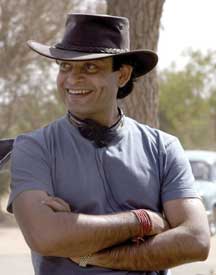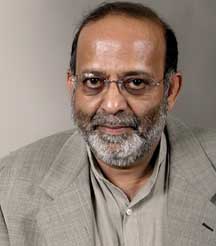Magazine
Bollywood Gamble

Indian Americans are investing in cinema, but will they lose their shirts?
Doctors do it, IT professionals do it, and even convenience store owners do it. No, we’re not talking about love, sex or marriage, but something almost as essential to life for Indians – cinema!
Param Gill of California is a practicing dentist, but he’s also the producer of Rockin’ Meera, a new Indie film for which he raised $1.5 million from his dentist friends and family. Dr. Kiran Patel of Florida and Dr. Ranga Reddy of Chicago along with other physicians have funded the development of a film project by Hollywood director Babu Subramaniam on the true Gandhian saga of an Indian doctor in America. Kiran Merchant, an architect in New Jersey, raised half a million dollars for his first film Quarterlife Crisis, starring Lisa Ray, Maulik Pancholy and Russell Peters, from several investors who are professionals like him. Vivek Wadhwa of North Carolina, former CEO of Relativity Technologies, used his IT connections to raise money for My Bollywood Bride. Currently an adjunct professor at Duke University, he is tapping investors for a second, more ambitious film.
Poonam Khubani, a businesswoman based in New Jersey, plugged over a million dollars of her own money into Aryan, her first full-fledged Bollywood venture, starring Sohail Khan and Sneha Ullal and flew in a celebrity fight-instructor from Australia for boxing scenes. Hand just about any desi a megaphone – and some moolah – and they think they can make a movie. Of course, cinema is India’s national malady and just about anyone from the subcontinent suffers from it. For them life isn’t life until it’s splashed on the big screen with seven superstars, six songs, two item numbers and a title like Kabhi Khushi Kabhi Gham. Not only do they cry and laugh, but feel they’ve had a reel dose of real life with all its spice. While Indians love watching movies, most secretly wish they could act, sing or even direct. The Bollywood factor seems written into our desi genes. So it comes as no surprise that Indian American professionals in America are finding another way to connect with their lust for cinema by investing in movies. Param Gill has worked on many a patient in his dentist’s chair, but is now himself sitting in the director’s chair and doing what most dental professionals only fantasize about – making his first feature film. He says, “I’m from India and as you know, there it’s one thing after another. After school, it’s dental school, and after dental school you’re a dentist and you never find time to do what you really want to do. And sometimes you have stories to tell and you want an outlet.” So, Gill took a course at the New York Film Academy, following which he made some short films, which fired him up to take on a feature film. Rockin’ Meera, an unconventional love story with an Indian heroine and an African American hero, shot partly in India, is scheduled for release in July.
Before trying to raise funds, Gill used his own money to first complete the soundtrack, featuring hot names like Sukwinder Singh and Shaan, which he then used as a calling card to attract investors: “This gave investors some faith that if they put their money into it, something would come out of it.” Who were the investors in his $1.5 million film? His story is not unlike that of scores of aspiring Indian American filmmakers who have made small budget films during the past two decades. “Well, basically the way it’s done is you put together a script and a business plan and essentially your friends and your family are your investors and you yourself are an investor,” he says. Most of the funds were raised through his dental contacts – and one can only hope he didn’t touch any clients for investments while drilling a root canal! “You need to know what kind of returns to expect from a project like that and there’s a best case scenario and a worst case scenario,” he adds. “Mostly the money comes from people who believe in you and the onus is on you not to lose the investment – and that is a very uphill task, because there are too many films being made and there are too few cinema halls out there.” The odds in the movie business are daunting and the vast majority of investors, perhaps as many as 80 to 90 percent, won’t see a penny. But that doesn’t seem to deter starry eyed Indian Americans. Every month you hear of a new movie venture in Silicon Valley or New York. Just about everyone from a physicist in California to a convenience store owner in New Jersey is putting money into movies. Kanwal Rekhi, the IT magnate, has an ambitious $7 million Imax film titled Taj Mahal in the works. Fresh-out-of-film school dreamers are busy raising money for their first feature film.
Babu Subramaniam, who’s been in Hollywood for 25 years working on TV shows like ER and Strong Medicine, is currently directing a Holly Hunter project for Fox TNT. He has seen many Indian Americans investing in small independent films: “There are a lot of mom and pop operations, people that put in money – jewelry store owners and restaurant owners, because their children want to do something with movies, the ABCD kind of movies.” Do these small investors have a prayer in this dog eat dog celluloid world of recouping their money? We turned to Deepak Nayar, who hit the bulls-eye with Gurinder Chadha’s Bend it Like Beckham, a low cost film that made millions around the world. He raises money through various independent financiers, a model that has not changed since Bend it Like Beckham. When doctors or IT professionals approach him with cinematic propositions, he says, “I ask them are you prepared to lose all the money? And if they say no, I tell them ‘You’re the wrong investor.’ Indeed, making movies is a very risky business. Let’s face it – you cannot be an investor in it as a one time investor.”
“I tend to have traditionally stayed away from independent one-time investors looking to invest – whether it’s the dentist, or the doctor or the IT guy,” he says. “I have always told them you have to look at it as a business and you have to treat it like a business. Traditionally these people who are attracted by the glamour of the movie business are not savvy enough, so most of my films are funded by companies that are in the business of funding films. If someone has $10 million, they invest 10 percent each in 10 different films so if one goes down they may recoup their money on another one – so you have to hedge your odds.”
Nayar says a hit like Bend it Like Beckham is a rarity. He went on to do two more films with Chadha, Bride and Prejudice, which did reasonably well and Mistress of Spices, which did not. “For me, it’s a profession, just like people work in a bank and take a nine to five job. This is what I do. I make films.” Advertising and marketing is key to a movie’s success. “To market a film in the US today on 3,000 prints is going to require a commitment of $30 million. Once you make these independent films there’s a lot of draw of the luck, which is you make them, you take them to film festivals and you hope they will become a success. Mostly they fall flat and there are very few and far between which take off.” And even that does not translate into profits, as Tirlok Malik, a restaurateur who made Lonely in America several years ago can attest. This critically acclaimed film is a cautionary tale of how things can go wrong with even a good product in the hands of novices. According to Malik, the film screened in 74 countries, 77 festivals, and ran on HBO. It made $30 million worldwide for his distributors, he says, but he did not see any of the money. “Since it was my first movie, I was not aware of the loopholes,” says Malik, who says the film was made on a $500,000 budget. “The distributors had the master copy of the film and could be selling it all over the world. The relationship between producer and distributor is part of the business of movie making and a producer is lucky if he has a good distributor.” Since then Malik has produced Arya, on a $60,000 shoe-string budget (excluding marketing) which did well in the DVD market and he has been involved in the line production of several films, including the big Rajnikant starrer Sivaji. He says, “Investing in a movie is generally considered risky, but if you keep the budget in control most likely you can make money out of this business. The problem happens when people go into it without knowledge or an appreciation of the larger picture. Sometimes a movie can make a lot of money and the investor still may not get anything back, because there are too many people along the way. That’s the reality of it.”
Raising money from individuals was a trial: “The care and handling of private equity investors is so enormous and painful. They don’t know movies, they don’t know about investing and then some of them proceed to give you advice on how to make movies. It’s so painful!” Saluja, who is the founder of the Silk Screen Film Festival, is now working on two new films, Chasing Windmills and Guru Maharaja Inc., but is planning to line up distributors first who can help him get his movie out and even assist in getting it made. He says: “There’s a saying in the venture capitalist world – there are two kinds of money: the right money and the wrong money. The right kind of money not only gives you money, but also opens doors for you. The wrong kind of money, which we unfortunately end up using, is the type from friends and family who know nothing about films and do it out of love or because they are curious or greedy.”
He finds it frustrating to educate them on a continual basis and just doesn’t have the stamina to do it all over again. He adds, “And of course I’m probably going to have to eat my words in the next few months if I can’t raise money through distributors!” Doctors came to the financial rescue when New Yorker Nanda Anand embarked on her first film, Return to Rajapur. The seed money was contributed by her husband, Dr. Vijay Anand, and a major investor was his colleague, Dr. Wellington Tichenor, along with several American businessmen. “When you are a first time filmmaker you have nothing to show investors, it’s really quite hard,” she says. “For investors putting their money into a small independent film, the chances of return are very poor. In my investing agreements it clearly states that the chances of you losing your entire investment is quite high. Understand that before you invest.”
So what draws investors to these risky ventures? She says, “The experience of being able to invest in a film, being able to go to the festivals, being able to meet the talent and being part of the whole filmmaking experience has more to do with it then looking for returns. Although there’s always the hope you’ll break even, but I don’t think that was necessarily the reason behind people investing.” Investors put in 60 percent of the money into this evocative film, which on a $1.5 million budget created a lush cinematic experience set in Jaisalmer. The budget included the cost of buying a luxury home and investors were happy that the film premiered at the Tribeca Film Festival and other prestigious festivals. They are now hoping for theatrical release and have sold DVD rights. “Whether we’ll really get any money back is really, really dismal. By the time the distributors take their cut, and the rep company takes its cut, we’ll obviously see nothing. Sometimes returns take 10 to 15 years, especially in films of this caliber. However, some of the American actors in the film have gone on to becoming well-known, so the chances are it may go in either direction.” But the impressive debut movie has opened doors for Anand and this time around investors are offering to produce her movie. She finds that generally Indians look for returns even on small investments, which she cannot guarantee so she prefers to turn to mainstream investors. Kiran Merchant, a New Jersey architect, is all set to release his film Quarterlife Crisis, but recalls that some investors actually came looking for him with money to invest, knowing of his past projects in theater: “These venture capitalists were looking to diversify their investment. This is a high reward, high risk kind of a business, but for most of the people who are involved in low budget films, there’s not a phenomenonally high risk since the investment is small. At the end of the day even if the film does not make money the feeling is they did something worthwhile, rather than put it in another IT venture that may or may not click.”
Merchant says raising money is just one part of a very taxing business: “I find that every aspect of film making is tremendously difficult and I’m looking at the art and passion as one part. At the end of the day it all comes down to business, and at every stage of the project you are basically dealing with business. “It’s 90 percent business and 10 percent art. This becomes very important and I’ve realized that in order to be a successful artist I have to be a successful businessman.” Distribution is the bane of every emerging filmmaker. He says, “You could make one of the best films ever, but if no one sees it, your business model fails. And the reason Hollywood studios have been so successful is not because they are making good movies, but it’s because they’ve cracked the code of the business model. They have an understanding of how much money to put in not only in the making of the film, but also in the marketing. For example, a big studio will make a film for $150 million and then they will spend $150 million marketing it. The ultimate culmination of this whole business process is that they are able to sell the movie and attract the audience.” His next project is budgeted at $5 million and he plans to use corporate or production company financing as well as individual investors. He says, “Indians are investing, but not that many. If you ask them for a $50,000 or $100,000 investment, they will do it, but if you ask them for half a million, they will probably shy away.”
Given the relative scale of investments, NRI investors are increasingly flocking to Bollywood, where costs are a fraction of those in Hollywood. However, Vivek Wadhwa’s experience making My Bollywood Bride has not been pretty: “I had been very bullish on this industry and need to warn potential investors about the downside. The experience was very negative and stressful, but the outcome may be okay.” The investors he pooled together were ex-IT executives and some affluent physicians. The problem, according to Wadhwa, was that some of the investors didn’t look at the project as a professional investment and were too easily seduced by the glamour: “What should have been a $500-800K project ended up costing over $2 million. There was virtually no accounting provided by the producer. The film has come out very good, and most audiences seem to love it, so there is some hope, but it wasn’t fun dealing with all the financial issues.” Wadhwa wrote a column in Business Week about his bitter experiences in both film capitals. “What is needed is professional and ethical management and this industry could provide very good investment opportunities,” he says. “The film is likely to release in the next 3-4 weeks. I hope it does well and we get our money back. It has good potential, but would have been a sure bet if we had not gone so much over budget.”
Another equally disillusioned investor in Bollywood is Poonam Khubani, whose company International Edge Inc., an infomercial distributor, produced Aryan, a Bollywood film with known stars. She originally put $500,000 into the venture, but the budget kept climbing. “We went almost double – and that’s largely one of these unseen things that happen in India. You start off with X budget and by the time you are done, it becomes just way too much to handle, and generally a producer thinks well, I’ve already sunk so much money, I might as well go into it all the way. The attitude should be, ‘Let me get out and cut my losses while I’m ahead in the game,’ instead of putting good money after bad.” What were the difficulties she encountered in making the movie in India? She says: “Even though we are Indians, we’ve lived a long time in the US and we have clarity in finance in this country. But India does not have that, especially in the Bollywood industry. You can figure that from the hiring of a camera crew or stunt people or crowd scenes, everyone gets paid off at every level – even your production assistant gets paid off! There are all types of bribes that happen there. It’s appalling, but that’s the way that world functions.”
“If the financial structure became a little bit clearer and I could be assured I would not be taken advantage of, then perhaps I would think about it again,” says Khubani. “As a producer one should have an upper hand, because you’re the one investing the money. But in India you have to toe the line of actors, director or anyone else who’s having a temper tantrum. “The producer is a person with a begging bowl who continuously begs people to give dates or give time, because he’s the only one interested in completing the movie, nobody else gives a damn. Bollywood is the world of wolves and one has to be really very cunning to deal with these people in the industry.” Mahesh Naithani, an IT professional passionate about art and music, can relate to Khubani’s frustration. He invested half-a-million dollars in Bombay Boys, starring Naveen Andrews and Rahul Bose. He put another $400,000 in Jai Ganga and $1 million in Such a Long Journey, starring Roshan Seth. He says he did not recoup his money in any of these ventures. “There was no accountability and there was not wide distribution,” he says. He recovered 90 percent of the money he put into Such a Long Journey but only 40 percent of his investment in the other two movies. None turned a profit.
He says he sold the rights to Bombay Boys to a well-known distributor for India, but found the film was shown in England without his permission. He says investors engaged in another profession just don’t have the time or the knowledge to be effective: “The financial accountability in India is complicated. A lot of cash money goes to a lot of people, so if you want to have very transparent accounting you can’t do it. They tell you they spent 20 lakhs, but they could have spent 10 lakhs, you just don’t know. There is no accountability. There can be all sorts of receipts, but you don’t know if it’s reality or not.” “A lot of illegal things happen because the fact is that Mahesh Naithani is sitting in the US. What can he do?” He adds, “You want to make a movie for fun’s sake, yes, you can. But you can’t do this professionally without full involvement because you’re basically doing something else. The lesson from this is that you can’t do things with just your left hand; you have to do it with both hands. Anyone who makes that mistake will have problems. If you’re a doctor it takes you 30-40 years expertise to become a good doctor. So how can you become successful in films without understanding the field?” One producer who hasn’t had to turn to dentists and doctors is Ashok Amritraj, the former tennis star who’s had a successful run as a Hollywood producer with his Hyde Park Productions. He started in the 1980s with private investors and profited from the boom in the video market. He made movies on $5 to $7 million budgets and was able to sell them to the video market, cable channels like HBO and Showtime as well as international markets.
In 1990 after the box-office success of his film Double Impact, his reputation led him to joint ventures with major studios. Hyde Park Productions has made films like Bringing Down the House and most recently Premonition, using studio financing and bank loans. Amritraj has been in the business for 25 years and recently completed his 95th film. Collectively his films have grossed over $2 billion worldwide. He says, “To play the game I play in requires a lot of money. The track record and the credibility are very important. It really starts with the screenplay and then it’s a question of your relationship with talent, agents and directors and how you package the script. We’ve had Angelina Jolie, Sandra Bullock, Steve Martin, Kevin Bacon and Kelly Preston in our films so it’s generally star driven vehicles that we’re largely involved with. That takes tremendous amount of relationships and then it finally boils down to distribution.” Amritraj has that sewn up too with his own distribution company for international markets and 20th Century Fox in the U.S. He says, “There are a lot of pieces, but at Hyde Park all the pieces are in place. So it’s a little bit different than someone coming up the street with a script trying to put it together. I think all those pieces have to come together and after that, how the movie does is quite frankly really in the hands of the Gods. You do your best and everybody wants to make good movies.” Which brings us back to the emerging film makers who are totally on their own, such as Param Gill and his soon to be released movie Rockin’ Meera. Is there hope without a big distribution machine and a giant studio behind you? Gill was at the American Film Market and realized that nobody was going to hold a novice film-maker’s hand through the distribution process, so he hired marketing professionals. “We now have a group of investors who have decided to release films and get into the distribution part of it,” he says. “We are hiring an agency which specializes in the distribution and publicity of films. We are testing the waters. We need to have a few big successes that produce solid returns. This will require professional management as we see in other industries like technology.” For novice investors and producers, Deepak Nayar offers this cautionary advice: “If you’re a one time investor you might as well as go to Vegas and gamble all your money – it’s as good as that really. Put your money on black or red on the roulette wheel and see which one comes up. Your guess is as good as mine!”
|





 He says that someone in the business of making films eventually will have a major success that will cover their previous losses. Every studio has its ups and downs – that’s the nature of the movie making business and risk is a given.
He says that someone in the business of making films eventually will have a major success that will cover their previous losses. Every studio has its ups and downs – that’s the nature of the movie making business and risk is a given. 
 The intimidating odds are only too well known to Harish Saluja of Pittsburgh, who made The Journey, starring Roshan Seth, in 1997, raising funds from investors who knew him through his publishing company, art gallery and radio program. He says, “Even if you can raise the money, distribution becomes a major issue. It took me five years before I was able to sell it piecemeal around the world and eventually to independent film channels.”
The intimidating odds are only too well known to Harish Saluja of Pittsburgh, who made The Journey, starring Roshan Seth, in 1997, raising funds from investors who knew him through his publishing company, art gallery and radio program. He says, “Even if you can raise the money, distribution becomes a major issue. It took me five years before I was able to sell it piecemeal around the world and eventually to independent film channels.” 




 Would she do it again?
Would she do it again?

 “Determining the profitability of a film is much more complicated than just looking at the budget and the North American gross,” he says. “Only a certain portion, roughly half, of the gross goes back to the distributor who in turn can have many kinds of deals in place with the producer.But then there is additional revenue that is earned from overseas theatrical markets, worldwide home video, and the sale of television rights.All kinds of deals are made including those involving flat upfront fees, revenue-sharing, or some combination. Therefore every film is on a unique road to profitability based on the deals struck by the producers.”
“Determining the profitability of a film is much more complicated than just looking at the budget and the North American gross,” he says. “Only a certain portion, roughly half, of the gross goes back to the distributor who in turn can have many kinds of deals in place with the producer.But then there is additional revenue that is earned from overseas theatrical markets, worldwide home video, and the sale of television rights.All kinds of deals are made including those involving flat upfront fees, revenue-sharing, or some combination. Therefore every film is on a unique road to profitability based on the deals struck by the producers.” Making a movie is just the first part. Marketing is a major undertaking, often costing as much as the movie or more. According to Ashok Amritraj. “We made Premonition for $20 million and spent over $40 million in marketing it. It’s currently made over $60 million at the box office and is projected to do about $100 million worldwide just in the theaters and then there’s video and TV rights.”
Making a movie is just the first part. Marketing is a major undertaking, often costing as much as the movie or more. According to Ashok Amritraj. “We made Premonition for $20 million and spent over $40 million in marketing it. It’s currently made over $60 million at the box office and is projected to do about $100 million worldwide just in the theaters and then there’s video and TV rights.” 